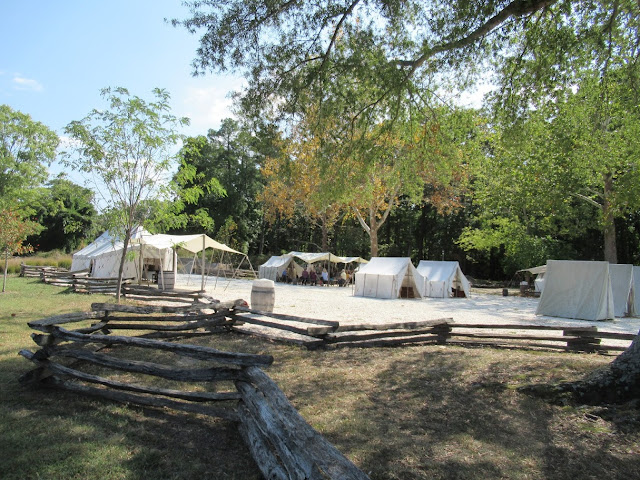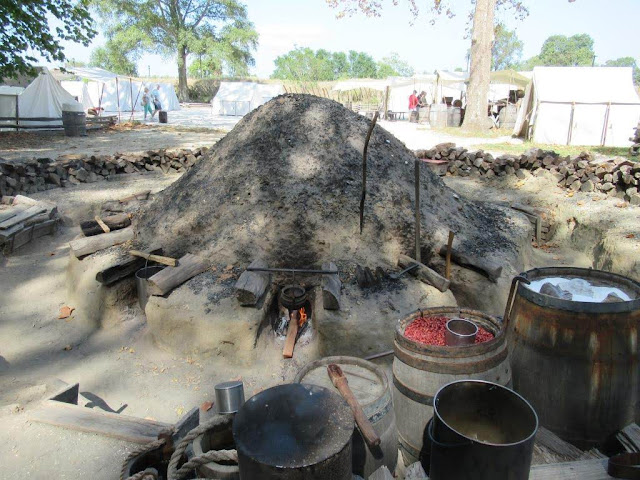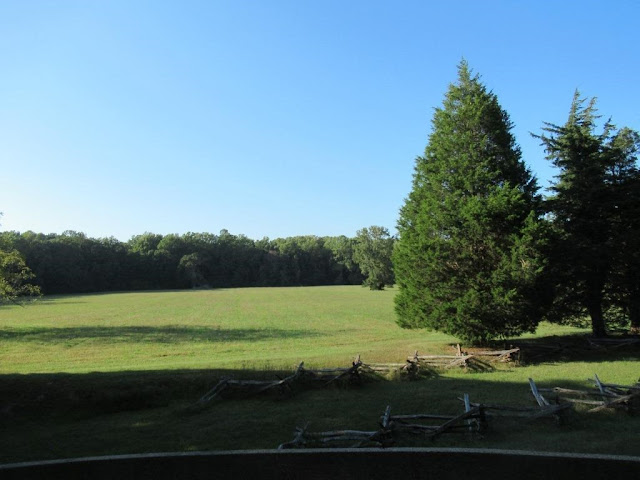From Jamestown, we headed north to the American Revolution Museum at Yorktown.

We watched their introductory movie before spending a couple hours inside the museum reviewing our Revolutionary War time history. Again, no photos, but the museum is so well done and we learned much!

Outside, we walked through the recreated Continental Army encampment and listened while “soldiers” told us about their life and experiences during the war.

This was the firepits used for cooking by the regiments. Each tent was assigned a section for their cooking needs.

The museum also had a Revolution-era farm with a family working the different areas.


The “mother” explained eating habits, food storage, and cooking during the time period.

We headed over the Colonial National Historic Park at Yorktown, run by the National Park Service after we finished our outside tour at the museum. We had free admission with our National Parks pass – we love having that pass!
We arrived in time to join a ranger-led talk about the final battle at Yorktown. He did a fantastic job explaining the history, the people involved, the part that luck and timing played in the siege, and the results. Tobey and I agreed it was probably the best ranger talk we have ever experienced!
We followed the Battlefield Driving tour making Redoubt 10 our first stop. On October 14, 1781, French troops helping the American troops stormed the British-held Redoubt 9 while American troops stormed Redoubt 10, capturing both positions in less than 30 minutes. This allowed the Allies to complete their second siege line and construct a Grand American Battery for siege artillery between the two redoubts. Three days later, British leader Cornwallis proposed a cease-fire. This is the remains of Redoubt 10. Much of the land has fallen into the York River over the years.

Our next stop was at the Moore House where officers from both sides met to negotiate the surrender terms for Cornwallis’s army on October 18, 1781.
 Eighty years later, during the Civil War, military action around Yorktown caused considerable damage to the Moore House. Sitting in between Confederate lines in Yorktown and the Union forces on Wormley Creek, the house was within easy range of shell fire. Later, foraging soldiers stripped away siding and other usable wood for fuel.
Eighty years later, during the Civil War, military action around Yorktown caused considerable damage to the Moore House. Sitting in between Confederate lines in Yorktown and the Union forces on Wormley Creek, the house was within easy range of shell fire. Later, foraging soldiers stripped away siding and other usable wood for fuel.The house remained derelict until 1881 when much needed repairs and some additions were made in preparation for the Centennial Celebration of the allied victory at Yorktown.
Between 1931 and 1934, the National Park Service, which had just established Colonial National Monument (later Historical Park), restored the Moore House to its original colonial appearance.
The driving tour continued to “Surrender Field” where Cornwallis’s army marched and laid down its arms on October 19, 1781. This ended the last major battle of the Revolutionary War and virtually assured American independence, even though the Treaty of Paris was the official peace treaty between the United States and Britain that ended the American Revolutionary War was not signed until September 3, 1783. The Congress of the Confederation ratified the treaty on January 14, 1784. King George III ratified the treaty on April 9, 1784 and the rest is history.

It was a long day, and we got back to the condo about 6 tonight. Tobey is fighting a cold so he is calling it an early night. Hopefully, he will feel better after a good night’s rest. Tomorrow we are hoping to visit Colonial Williamsburg.

No comments:
Post a Comment